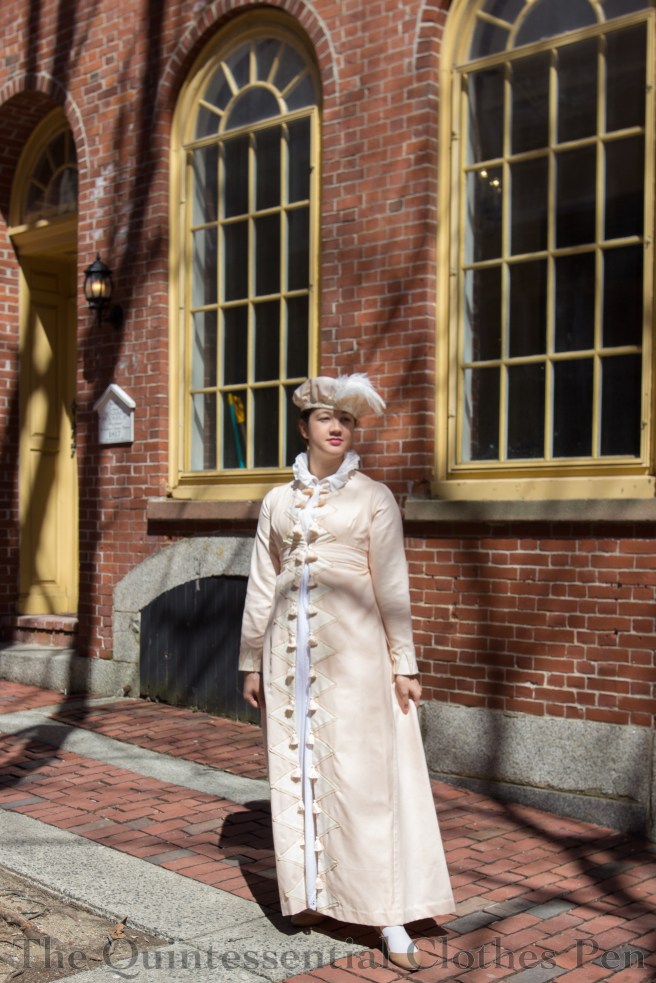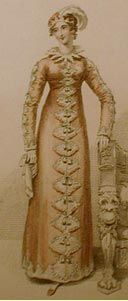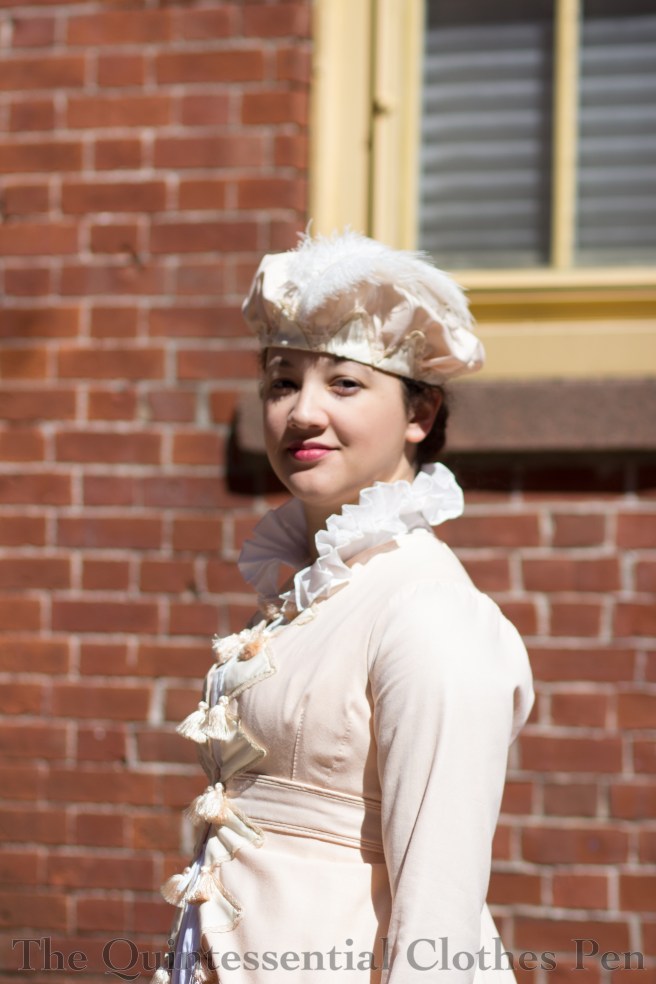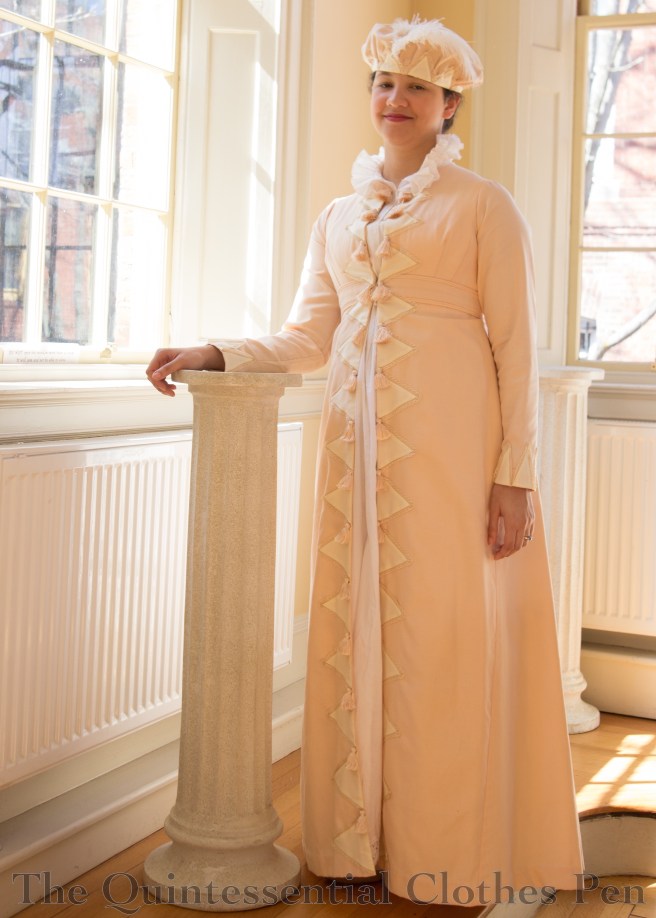At least three years ago I was inspired by a fashion plate, as one often is, and started working on a Regency pelisse following the design in the image. I got really far along, finishing the construction and even part of the trimming, but then stalled and let the ensemble languish for years before determining to pick it up and finish it off this year or else! I’m excited to have finally reached a ‘done’ point in this project so I can remove it from the UFO list!
The pelisse (and hat) are directly inspired by the following fashion plate, which can be seen here with slightly different coloring and here in black and white. In the first of those two links, the garment is labeled as a dinner dress, but I thought the design would make excellent pelisse trimming and so I adapted it.
You’ll notice, perhaps, that the finished pelisse does not have as much trim on it as the inspiration image. Early in this project, before it languished, I cut out all of the appliqués for the neck, sleeves, and hem as well as the front edges. I pressed under a 1/4″ on each side of each piece, too. And then, as I was finishing all that triangle trim on the front earlier this year, two things happened:
#1- I lost steam and really just needed to be done with this project.
#2- I decided I liked the simplicity of the pelisse without the extra trim. It’s so easy to draw lots of details, but then in a real garment the details don’t always translate. For example, the triangles around the neck just looked bad and awkward (plus, I wonder if that is a chemisette collar and not trim on the dress itself?) and the sleeves just looked too crowded. I was also afraid that putting all that work into triangles around the hem would just get dirty and not be a good use of many more yards of the vintage lace I used to edge the triangles.
In fact, despite the somewhat-simplified trim, there are actually a lot of details in the construction of the pelisse. Each back seam is piped and the belt has double piping above and below it. The neck is bound with piping, which is sewn with small, invisible stitches around the neck to hold the seam allowance to the inside. Also, the skirt is knife pleated into the back, allowing for a nice silhouette from all sides.
The pelisse is made entirely from peach colored cotton. It is unlined, except on the belt, where it is lined in order to hide the raw edges. The other seam allowances are whip stitched to keep them tidy. Here is an inside view of the bodice section. I do like my insides to be tidy!
The trim fabric is a cream colored poly/cotton blend. Each triangle is edged in very light tan vintage lace. Then, to top it all off, there are peach tassels on each triangle down the front as well. The peach tassels were removed from a length of upholstery trim that happened to be a perfect color match!
The pelisse is machine sewn on the interior seams and hand finished, including the hem, neckline, seam allowances, and all that trim. The darts are also sewn by hand with a small running stitch, a detail I picked up from looking at extant pelisses, though of course it’s been so many years now that I can’t find a specific example. I like how the top stitched darts at a little extra interest.
The pattern for this pelisse is of my own design. I’m pretty sure it was based on my 1819 spencer, but adapted slightly for a different fit. It’s hard to remember since it’s been so many years since I made the pattern! The skirt is a large rectangle–two panels of fabric seamed at center back.
I’m wearing the pelisse with the following garments: a chemise and my short stays, my Vernet petticoat , my recently finished chemisette, and the hat that matches the whole ensemble. I’m excited to have found a use for the Vernet petticoat that shows off the trim at the hem! I did take out the tucks that made it the right length for my Witzchoura so that it would be the right length for the pelisse, but that’s what tucks are for, right? On picture day there was a nice breeze blowing everything around and showing off all the layers nicely.
I was lucky to take these photos in and around some of the Regency period buildings in Salem, MA. You can’t beat buildings from the right period for a suitable backdrop for a garment like this!
Now I have my first pelisse. More outings will hopefully arise in the future so I can wear it again. I’m so glad I’ve decided it’s finished and that it was a comfortable garment to wear, though I maintain that the hat is a bit silly.












OMG!!! I love it 🙂 Wonderful details and the true 1814 silhouette.
I’m very fond of your alterations to the original design…the light colour is perfect for a walk in the park in spring, looks like being right out of an English fashion journal!
P.S. It’s so lovely that you give a hint on how the tucks on petticoats help to adjust dress and outerwear, hope many will listen 🙂
Thank you so very much, Sabine! I appreciate your thoughts. 🙂
always enjoy lurking here and checking up on your creations….you are one talented lady.
Do you ever participate in the historical activities at Nahant in August?
Thanks, Tara. I’m glad you’ve written a comment so I know you’re there. I have been to the Nahant events in the past, but have been unable to attend recently.
This is a really lovely outfit. The simplicity adds to the elegance, and draws my eye to it far more than a fussy one would. I totally enjoy seeing what you are doing in the sewing world!
Thanks on all counts! 🙂
Love the tassels! How fun is that? And it must be lovely to have it finished
Thanks! They do add a certain something to the finished pelisse.
We went last year, a bit of a haul from Glassboro NJ but all in all a great experience. The downside was the heat….first week in August, and nearly 100 degrees each day, most of our venues were unairconditioned.and I was ditching petticoats and bloomers right and left, But I’d do it again this year, if theres time and cash available! You always meet such interesting people.
Yes, that is rather a trek. It is almost always very warm around Boston in early August, unfortunately. Luckily, there is still fun to be had, despite the heat!
Hello! This post is timely! I need to make a summer pelisse. May I ask what type of cotton you used? Thank you.
Hi Angela! This cotton is a plain weave light to medium weight from the bargain store, so it didn’t come with helpful labeling in terms of type. It behaves rather like a quilting cotton, though the weave is not as tight as those often are. Sorry I can’t be more specific!
Wow! Such a nice and elegant piece of work- and I love the “breeze” photo!
Thank You for sharing this eye-candy ❤ 🙂
Thank you! I’m so pleased there was a breeze and we were able to get a good photo of it blowing the clothing around! 🙂
This is beautiful! I love the matching hat, too!
Thanks! 🙂
Ooo I just love the tassels! And the color is lovely!
Caroline
It’s lovely! Love all the little tassels, and the piping on the seams really finishes the whole look. (The hat is also amazing by the way!)
Hello! Thank you! 🙂
What an absolutely gorgeous pelisse and hat! I love all the detailing and the fit is just perfect!